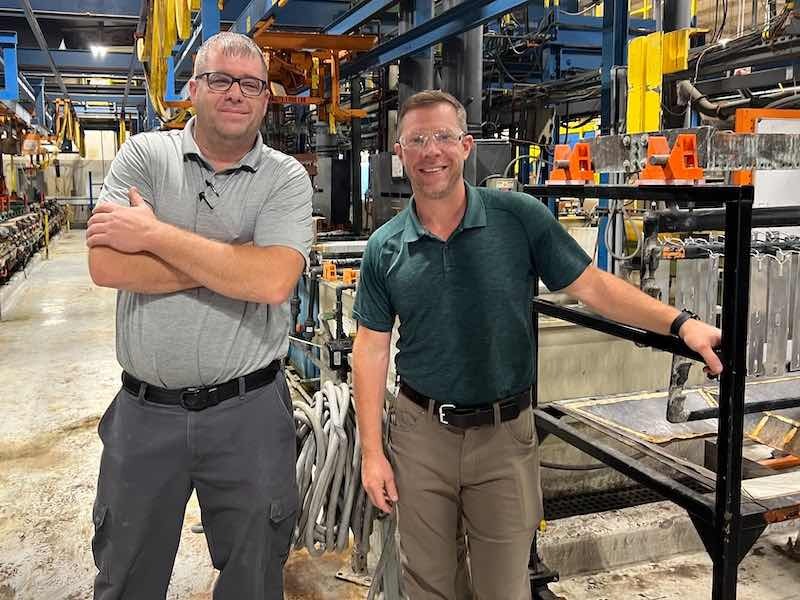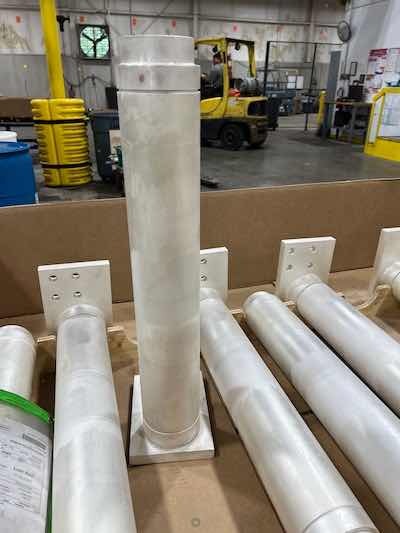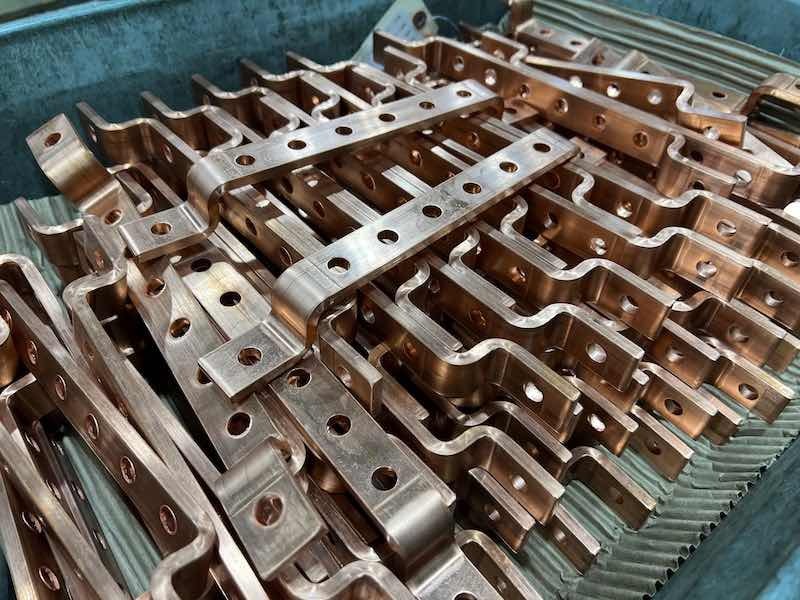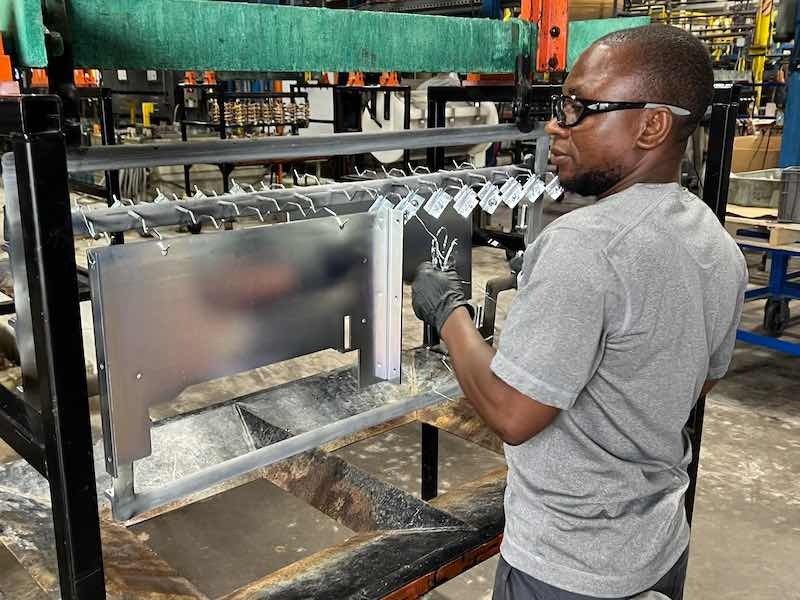There are not too many manufacturers who choose to get into the electroplating business, given the regulations and hurdles that come with opening their own lines.
But Cincinnati-based Monti — which specializes in manufacturing and fabricating conductors, insulators, and steel parts for the electrical industry — is grateful for taking the step back in 2011 to do just that.
“It is a heartburn to send your parts out and you have no idea when they’re coming back,” says Chris Narburgh, Vice President of Operations at Monti, who oversees the finishing aspect for the company.
“And when they do come back, are they going be to spec?” he says. “We made the decision to get into the plating business only because of the weak supply chain. There are fewer and fewer platers in the market, and that can cause issues.”
Starting Their Own Plating Operation
 Joe Tekuelve, left, is the Plating Solutions Plant Manager and Chris Narburgh, Vice President of Operations at Monti, who oversees the finishing aspect for the company.That led to Monti starting Plating Solutions a few miles from their manufacturing operation, where it specializes in plating in silver, tin, zinc, and other finishes specifically needed in making components and assemblies for the electrical industry.
Joe Tekuelve, left, is the Plating Solutions Plant Manager and Chris Narburgh, Vice President of Operations at Monti, who oversees the finishing aspect for the company.That led to Monti starting Plating Solutions a few miles from their manufacturing operation, where it specializes in plating in silver, tin, zinc, and other finishes specifically needed in making components and assemblies for the electrical industry.
“Monti’s secret to success is responsiveness, and adding finishing was a key part of that,” Narburgh says. “It was about taking care of our customers, responding to them, and doing what it takes to keep them going.”
Monti has manufacturing operations in Cincinnati as well as three in South Carolina. In 2005 they added a powder coating operation in its Greenwood, SC facility doing low-volume parts using racks and an 8-foot deep oven.
The Greenwood plant now has a fully automated line and a fully automated spray booth with a reclaim system, which includes a 4-stage washer system. They also have two manual spray booths as well. In addition, the facility has a fluidized epoxy powder system to dip heated parts into a fluidized (aerated) bed of epoxy powder to obtain very high insulation properties and suppressed arcing.
Plating Solutions’ business is about 66% work directly from the parent company, Monti. The rest of the work comes from outside manufacturers, but it is almost all electrical components for other manufacturers in the industry.
Two Silver Plating Lines and More to Come
 Powder conductors are plated silver to protect the copper surface and to provide increased conductivity.Joe Tekuelve is the Plating Solutions Plant Manager and says the company has two silver plating lines but plans to add another silver line within the next few years to accommodate the fast growth of the electrical industry.
Powder conductors are plated silver to protect the copper surface and to provide increased conductivity.Joe Tekuelve is the Plating Solutions Plant Manager and says the company has two silver plating lines but plans to add another silver line within the next few years to accommodate the fast growth of the electrical industry.
“We are seeing a tremendous amount of growth in the electrical sector, and not just from Monti but other manufacturers, too,” Tekuelve says.
The United States has experienced a striking surge in construction spending for manufacturing facilities, as real manufacturing construction spending has doubled since the end of 202, according to the U.S. Department of the Treasury.
“The boom is principally driven by construction for computer, electronic, and electrical manufacturing—a relatively small share of manufacturing construction over the past few decades, but now a dominant component,” says Eric Van Nostrand, Acting Assistant Secretary for Economic Policy.
In fact, Van Nostrand says that since the beginning of 2022, real spending on construction for that specific type of manufacturing has nearly quadrupled. And with every new — or even refurbished — manufacturing operation is a demand for electrical components that supply energy to the buildings.
Silver is the preferred plating option for copper busbars — which are typically housed within panel boards, switchgear, and busway enclosures — because it provides stable contact resistance and a low maximum operating temperature that increases the service life of the parts.
While copper is already resistant to corrosion and rust, adding silver, tin, or zinc ensures the busbars won’t oxidize over time, which could be catastrophic.
Adding Plant Manager and Wastewater Expert in One
Tekuelve joined Plating Solutions in 2020 when Narburgh and the Monti management team recruited him to work for them. After starting his career in the plating industry, Tekuelve spent the previous 15 years as a wastewater specialist with Veolia Water Technologies, where he learned the ins and out of treatment systems that prepared him for taking the job at Plating Solutions.
One of his first tasks on the new job was beginning work on replacing and expanding the shop’s wastewater system and getting it ready to handle more work.
“We had to turn a lot around when I came here,” Tekuelve says. “There were some issues that needed to be addressed, such as changing some of the concentrations of the silver and tin tanks and how we improved stripping the racks. That was the start.”
“There won’t be any interruption, which is a big plus on this project,” says Mike Quandahl, Global Strategic Account Manager at MacDermid Envio. “When the new one is ready, we can demo the old one without them skipping a beat.”
Tekuelve had six employees when he started in 2020, and that number has grown to 14 as the workflow has increased and the demand on the plating lines and wastewater treatment has grown.
In January, Plating Solutions began working with MacDermid Envio Solutions on designing a new wastewater system that can handle the increased throughput of the facility. After the design was approved and the proper permits granted, Plating Solutions hopes to start deconstructing and then constructing the new system in October.
Tekuelve says it should take three to four weeks for the complete installation to take place.
“We are treating about 20 gallons per minute, and we are fairly close to maxing that out,” he says. “The new system will be 40 gallons per minute and include a cyanide treatment that has a filter, press, and everything we will need.”
Older System Replaced by New Technology and Capacity
 Mike Quandahl, Global Strategic Account Manager at MacDermid Envio, says the existing wastewater treatment plant was an older system that had structural issues. The goal was to bring it up to date and add capacity.
Mike Quandahl, Global Strategic Account Manager at MacDermid Envio, says the existing wastewater treatment plant was an older system that had structural issues. The goal was to bring it up to date and add capacity.
“Their existing system was right in the middle of the production floor, and that is prime real estate,” he says. “They definitely needed a newer system, and one that could handle what they needed in the future.”
The benefit of relocating the new wastewater treatment system is that the existing one can still operate, and the installation won’t affect production.
“There won’t be any interruption, which is a big plus on this project,” Quandahl says. “When the new one is ready, we can demo the old one without them skipping a beat.”
MacDermid Envio is designing and utilizing its own controls and maintenance software in the new system, which is a huge plus when it comes to dialing in the treatment plant. While they do outsource some components, MacDermid Envio installs and takes full responsibility for the system success. The PLC will be controlling and collecting the operating data of the system.
“That is nice because we can put together a project and meet whatever the customer’s wants and needs are for controls,” says Quandahl, who credits Tekuelve and Narburgh for thinking into the future so that the new wastewater system will function properly for years to come, and be able to handle any additional capacity needs when new lines are added.
“Way too many shops install whatever they need for today, and then they don’t have the planning built in those,” he says. “They have picked a technology that is very happy to run at about 50% capacity in the beginning. When they add their extra plating line, they will still be in great shape.”
Plating Demand Increasing
 Wastewater isn’t new territory for Tekuelve, who installed about 15 systems for clients when he was Veolia before coming to Plating Solutions.
Wastewater isn’t new territory for Tekuelve, who installed about 15 systems for clients when he was Veolia before coming to Plating Solutions.
“The big issue is to keep us in compliance,” he says. “I have an industrial wastewater license, so that gives me a huge advantage because not only do I have my eye on the plating part of the business, but I want to make sure we are doing all the right things in the wastewater area, too.”
Narburgh says the new silver plating line and the new wastewater treatment system are coming on at just the right time.
“There is no doubt that the demands have increased, certainly over the last 18 months, and specifically in the last six months,” he says. “We believe we have the capability to do more here in terms of our plating processes. And our plating operation is the catalyst to growth here at Monti, and that is why we are investing heavily into it.”
Tekuelve says the new wastewater system will be easily able to handle 40 gallons per minute but could do more if need be.
“I could probably get 50 or 60 gallons out of it with a couple of modifications,” he says. “But it could also go to 80 gallons five years down the road if we need it.”
Narburgh says the additional lines and wastewater system will not only handle Monti’s continued growth in the electric component industry but also help them take on more work from outside customers, too.
“Monti is around 66% of our business at Plating Solutions, and one-third of our business is external,” he says. “Just a year ago, the ratio was about 92% Monti and 8% external. So that’s why we need to get our infrastructure right for the future.”









































